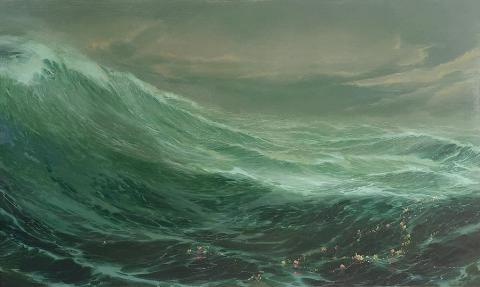THE WAVE AND GARLAND, 1999
TIM STORRIER
synthetic polymer paint on linen
91.5 x 152.5 cm
inscribed verso with title
Sherman Galleries, Sydney
Private collection, Sydney, acquired from the above in 1999
Recognised by the Australian art world at an early age, Tim Storrier spent many years exploring Australia's dry earth, fire and sky in a series of paintings that favoured strong horizon lines and horizontal compositions. Storrier's interpretation of the elements shifted significantly in the late 1990s, when he moved from fire and earth to a suite of sea paintings which manage to convey 'an entirely different kind of wild vastness.'1
The artist's biographer Catherine Lumby suggests that Storrier's seascapes are the work of an artist who has learned to harness his vulnerability and sense of isolation. Lumby credits the series as being some of the artist's strongest work to date, representing an increased maturity in texture, composition and emotional depth that marks a painter in full command of his craft.2
The Wave and the Garland is a significant example of the work produced in this period. The seascape's composition is dominated by a diagonal line formed by the swell of the sea in a wave that threatens to overwhelm a small circle of blooms located in the adjacent corner of the picture. Floating in a patch of dark water, the ring of flowers, which might be a garland or a wreath, is slowly disintegrating. The delicate flowers, usually anchored in the earth, will soon to be overpowered by the wave.
The ocean is 'one of nature's powerful emblems - an icon of resistance to the civilising forces of culture and of attempts to impose order on the world.'3 The ocean takes on a symbolic significance for Storrier in this series, as he continues his examination of unexplored and unharnessed terrain.
1. Lumby, C., Tim Storrier: The Art of the Outsider, Craftman House, Sydney, 2000, p. 144
2. ibid., p. 145
3. ibid., p. 147
JESSICA O'BRIEN
